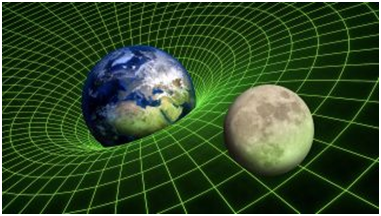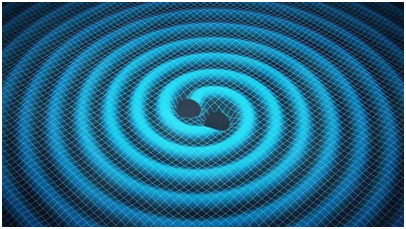Go to AFOMP Pulse Contents/Index Page
Gravitational Waves – Einstein was right again !!!
(By Stephen Tronchin, University of Adelaide)
Almost 100 years ago Einstein predicted the existence of gravitational waves in his Theory of General Relativity. Scientists began the search in the 1960s, and in 2015 gravitational waves were detected for the first time.
What is gravity?

Credit: Shutterstock.
Gravity is one of the four fundamental forces of nature. The gravitational force is described by Einstein’s General Theory of Relativity, the accepted theory for gravity. According to Einstein, gravity is not a force in the traditional sense, but rather the curvature of spacetime caused by mass and energy. Massive objects create curvature in the fabric of spacetime around them, and this curvature is what we perceive as gravity. If we consider the Moon rotating around the Earth, the Earth does not exert a force on the Moon, instead the Earth bends the fabric of space surrounding it and the Moon is moving through this bent space. Think of placing a heavy ball on a sheet – the sheet bends and other objects placed on the sheet will move toward the heavy ball.
So where do gravitational waves come from?

According to Einstein’s theory, when a mass accelerates it is changing the curvature of spacetime in its vicinity. These alterations in the curvature of spacetime spread out as waves through the fabric of spacetime. Think of swirling your finger on the surface of water, as you slow down or speed up the motion, ripples of water propagate outward from your finger. But in the case of gravity, these are waves of spacetime itself, not water.
The greater the mass and acceleration, the stronger the gravitational waves. When two super massive objects, such as black holes or neutron stars, orbit each other and eventually collide, they undergo rapid acceleration and emit strong gravitational waves in the process, strong enough to be detected on earth.
First detection of gravitational waves!
Over a billion years ago in a distant galaxy, two black holes were orbiting each other. As they orbited, they emitted gravitational waves which carried energy away from the system. Over millions of years, this caused the black holes to orbit closer and closer. As they got closer, they orbited faster, emitting stronger gravitational waves, causing more energy to be lost from the system, causing the black holes to get even closer. The two black holes were locked in an accelerating spiral. Lose energy, get closer, orbit faster, lose energy. Then, around 1.3 billion years ago, the two black holes collided head on. The acceleration in the last moment was so great the impact occurred as the two were approaching the speed of light. The explosive merger formed a new black hole with a powerful gravitational field, sending out ripples in space time as the new object was formed. Think of the moment of merging like dropping a large rock into a pond. In our case, the ripples propagate through spacetime.
The effects of gravitational waves are small, and the strength of gravitational waves decrease as they propagate from their source, making them difficult to detect. The development of very sensitive laser interferometers at LIGO made it possible to detect the gravitational waves from the black hole merger. Because light travels through space, any distortion in space will affect the path of the light. LIGO’s instruments are designed to detect gravitational waves emitted in the last few orbits before two objects collide, as these signals have the largest frequency and are easier to pick up over background noise. By very carefully analysing beams of laser light, scientists at LIGO were able to detect the distortion of laser light as the gravitational waves from the black hole merger passed through earth, winning LIGO researchers the 2017 Nobel prize in physics.
It is an exciting time!
Detecting gravitational waves allows scientists to study and learn more about super massive objects like black holes and neutron stars. We can listen in to the cosmos like never before.